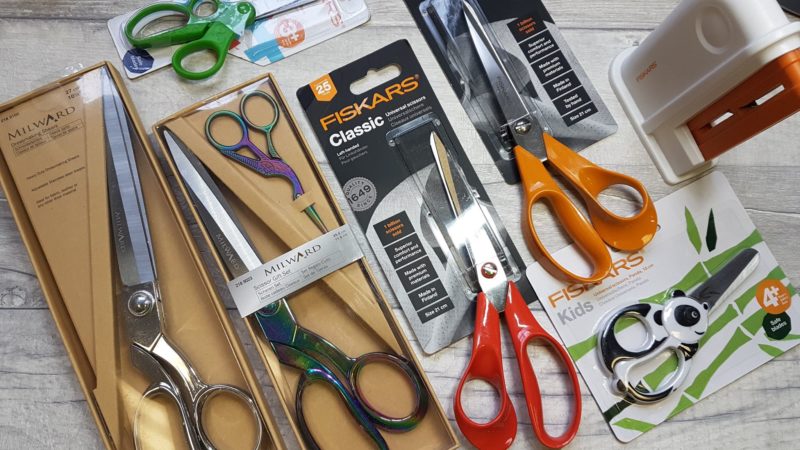
So many people have a strong preference to using either scissors or a rotary cutter.
Others have only ever tried one type and are cautious to try doing things another way.
Cutting tools can be a personal thing and no single tool is perfect for everyone, or for every fabric.
Here we give you a quick run down of some of the options and some pros and cons so you can make up your own mind what works for you.

Everyone has used scissors at some point in their lives so they feel easy and familiar to use.
Scissors allow you to cut accurately and close to the pattern if you keep the lower blade on the cutting surface. They are also great for cutting fiddly bits as the scissors are easily manoeuvrable.
Heavier fabrics aren’t a problem for most sharp scissors and they can handle multiple layers with ease.
Sharpening scissors is really easy – you can use a handheld sharpener or a freestanding sharpener.

Have separate scissors for each task – e.g. don’t use the same pair for paper and fabric! This is because the paper will blunt the fabric cutting blade. You may like to mark your fabric scissors with a piece of ribbon to differentiate them…or a padlock!
Always close your scissors when they’re not in use and store them out of reach, blade down for safety.
Sharpen them regularly with a dedicated sharpener – this prolongs the life of your scissors and keeps them cutting accurately and neatly.
Fiskars have been making Scissors since 1832 and are extremely good at making a huge range of cutting equipment, they have a great variety of sewing scissors of various lengths and designs, plus children’s scissors to encourage crafting from an early age.
Another popular choice for scissors is Milward – they excel in beautiful traditional shears that are not only attractive but do the job wonderfully. These Milward scissors are a popular choice for gifts in particular.

Rotary cutters were first brought to market by Olfa in the 1970s, yet lots of sewists have never used them. Some feel frightened by the blade, others like to stick to what they know without learning to use a new skill.
In quilting circles rotary cutters are a must have, and that trend is slowly being picked up by garment makers.
Although rotary cutters need more supporting tools to work at their best, they more than make up for it with speed and accuracy.
Rotary cutters really come into their own with straight lines. Used with a quilting ruler you can measure and cut at the same time, drastically reducing the time it takes to cut waistbands, cuffs and necklines.

Some struggle with a rotary cutter when they first start – the key is to use a high quality mat as cheaper ones can dull your blade within a few cuts.
Practice your technique until it feels comfortable and cuts accurately. It may feel natural to hold the cutter perpendicular to the table but if you hold it at an angle, you get a smoother cut.
Pattern weights are your friend for keeping everything stable. If you don’t have pattern weights you can use canned food or make your own. We love this pattern by Rebecca Page.
Don’t be afraid to try different sizes and types of rotary cutters, there are many different options depending on your dexterity and nimbleness.
A quilting ruler is a must have for straight lines using a rotary cutter. Don’t use a metal ruler as it can quickly blunt your blade. A suction handle is perfect for keeping the ruler steady but keeping your fingers out of the way.
There are many types of rotary cutters and different sizes. 28mm and 45mm are the most popular sizes as they are versatile enough to be used for most projects. Different types of rotary cutters include retractable, quick change blades, squeeze handle, ergonomic fit and much more.
The type of rotary cutter you need will depend on your cutting technique and the types of projects you’re sewing, as well as your dexterity. If sewing around children or pets a blade that retracts when the handle is released is highly recommended.
Rotary cutters are best used with rulers and cutting mats for accuracy and speed. Mats and rulers come in a variety of sizes and have different features such as types of measurements and the material.
Ultimately when it comes to scissors vs rotary cutter, it depends on the job and your preference.
There is no right answer and it may vary from task to task but you can definitely find benefit in having both tools.
Which do you prefer?
Let us know in the comments